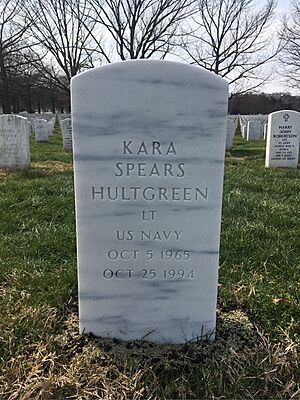Kara Hultgreen facts for kids
Quick facts for kids
Kara Hultgreen
|
|
|---|---|

Hultgreen with an F-14 Tomcat
|
|
| Nickname(s) | Revlon |
| Born | October 5, 1965 Greenwich, Connecticut, US |
| Died | October 25, 1994 (aged 29) off San Diego, California, US |
| Place of burial | |
| Service/ |
United States Navy |
| Years of service | 1987–1994 |
| Rank | Lieutenant |
Kara S. Hultgreen (October 5, 1965 – October 25, 1994) was an American naval aviator. She was a lieutenant in the United States Navy. Kara Hultgreen made history as the first female fighter pilot to fly from an aircraft carrier for the U.S. Navy. She was also the first female fighter pilot in the U.S. military to die in a plane crash. This sad event happened just months after she was approved for combat missions. Her F-14 Tomcat jet crashed into the sea while she was trying to land on the USS Abraham Lincoln aircraft carrier.
Contents
Early Life and Education
Kara Hultgreen was born on October 5, 1965, in Greenwich, Connecticut. Her grandparents on her father's side were from Norway. She grew up in different cities, including Chicago and Toronto. Later, from 1981, she lived in San Antonio, Texas. She went to Alamo Heights High School. After high school, she graduated from the University of Texas at Austin in 1987. She studied aerospace engineering, which is about designing and building aircraft and spacecraft.
Military Career
Kara Hultgreen joined the Navy through the Aviation Officer Candidate School. She was a top student there.
After finishing her initial training, she went to Naval Air Station Corpus Christi, Texas. There, she learned to fly the T-34C Turbomentor plane. She was chosen to become a "Strike Pilot," which means flying combat aircraft. She continued her training in other jets like the T-2C Buckeye and TA-4J Skyhawk II.
Once she became a certified naval aviator (a Navy pilot), she was assigned to fly EA-6A Prowler jets. These planes are used for electronic warfare. In May 1993, the Navy decided to allow women to fly combat planes. Lieutenant Hultgreen was chosen to be one of the first female pilots to train on the F-14 Tomcat at NAS Miramar, California.
While training to fly the F-14, she had to learn how to land on an aircraft carrier. This is called "carrier qualification." She didn't pass her first attempt. But she tried again in July 1994 aboard the USS Constellation and succeeded. This made her the first female naval aviator qualified for combat missions. After completing her training, she joined Fighter Squadron 213 (VF-213). She began getting ready for a mission to the Persian Gulf.
Her pilot nicknames were "Hulk" or "She-Hulk" because she was strong and tall. She could lift 200 pounds! After she appeared on TV wearing makeup, she also got the nickname "Revlon".
Her Final Flight
On October 25, 1994, Kara Hultgreen died when her F-14A Tomcat crashed. This happened while she was trying to land on the USS Abraham Lincoln aircraft carrier. She was the first female fighter pilot in the U.S. military to die in a crash. The accident happened near the coast of San Diego during a training mission.
As she was coming in to land, her jet was a bit off course. She tried to correct it, but this caused a problem with the airflow to her left engine. The engine lost power. When an F-14 loses an engine, it can be very hard to control, especially at slow speeds.
Lieutenant Hultgreen tried to recover by using full power on her other engine. However, this made the plane even harder to control. The jet quickly rolled to the left and became uncontrollable. The radar intercept officer, Lieutenant Matthew Klemish, who was in the back seat, ejected from the plane. He survived. But by the time Kara Hultgreen's seat ejected, the plane had rolled over too much. She was ejected downwards into the water and died instantly.
Nineteen days later, on November 12, the Navy found the plane and recovered Kara Hultgreen's body. She was still in her ejection seat, at a depth of 3,700 feet (1,128 meters). On November 21, she was buried with full military honors at Arlington National Cemetery.
Her landing attempt was recorded by two cameras, as is common for carrier landings. The video showed the jet going off course, then the engine problem, and finally the plane stalling, rolling, and the crew ejecting before it hit the water.
Questions and Discussions
After Kara Hultgreen's death, some people raised questions. They wondered if the Navy was putting political goals ahead of safety. Some activists suggested that female pilots, including Kara Hultgreen, might have been allowed to continue training even if their performance was not as good as male pilots. They claimed this was because the Navy wanted to have female fighter pilots quickly.
A pilot named Francesco "Paco" Chierici, who also flew F-14s, later said that the way Kara Hultgreen was treated after her death was unfair. He pointed out that another pilot in her squadron had similar problems in a flight simulator almost all the time. The Navy denied any favoritism in training.
See also
- Modern United States Navy carrier air operations
- Dagny Hultgreen (sister)


